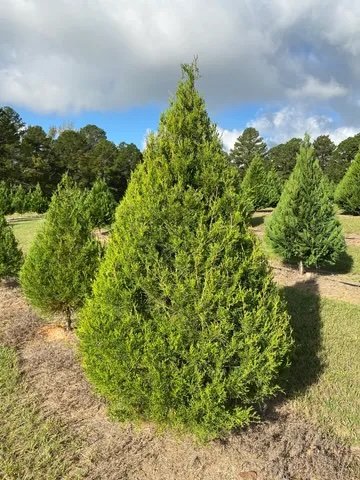
Tree Varieties
Eastern North Carolina Christmas tree growers have a variety of trees to o5er, from Leyland Cypress to Virginia Pines. Growers are now producing trees that have grown naturally in eastern North Carolina for hundreds of years. For example, older folks remember the days when they would go into the forest with their grandparents to Dnd and cut the old traditional Red Cedar Christmas tree. That tradition continues today as families Dnd their way to the numerous choose & cut Christmas tree farms scattered throughout eastern North Carolina for the enjoyable and rewarding experience of Dnding their “perfect” tree.
For the freshest tree and a memorable, fun Dlled family experience, travel to an Eastern North Carolina choose & cut Christmas tree farm. There, you will breathe deeply to enjoy the fresh fragrance of the trees while Dnding and cutting your perfect tree. To add to your treasured memory, many farms o5er accessories, hayrides, feeding or petting animals, hiking, and hot chocolate or apple cider.
As you consider searching for and purchasing your real tree, remember that the trees in the “wild” may look smaller than the relative space you have available in your home. So, before making a trip to the choose & cut farm, measure the space available relative to the diameter and height of the area for the tree. The height of the tree should be at least six inches less than the height of the ceiling to allow space for the stand and prevent damage to the ceiling. Consider whether the full tree will be seen, or, will it be in a corner; a tree with a bad side may be less costly but have the same beautiful appearance in your home.
-

Blue Ice
The Blue Ice has foliage that is silvery blue in color, soft to the touch, and very dense with an outstanding aroma. Due to their tendency to dry out even in water stands, it is recommended to cut these three to four weeks before Christmas.
-

Carolina Sapphire
The Carolina Sapphire is a clean tree that does not drop dead needles and has a strong, clean, piney aroma. The foliage is thick with a beautiful light blue-green color. It is also relatively new to the Christmas tree family.
-
Eastern Red Cedar
The eastern Red Cedar is the old southern traditional Christmas tree, and is loved by many. The foliage is a dark, shiny, green color and has a distinctive fragrance. Foliage is thick but the branches are flexible and will only support light ornaments and decorations of ribbons. If the tree is kept watered, it will last throughout the season.
-

Green Giant Arborvitae
The green giant is the newest tree to be used as a Christmas tree and has become very desirable. Like the Leyland and Sapphire, it does not drop dead needles. Another appeal is its sweet, almost perfumed aroma. It is a rich green color with Battened branches.
-

Leyland cypress
Leyland cypress is new to the Christmas tree family of trees. It has become very popular because it makes a beautiful, conical, long lasting tree and does not drop needles. Branches are feathery and are a bright green color. Branches do not support heavy ornaments.
-

Virginia Pine
Virginia pines are the "scotch pines of the south" and also known as the "Charlie Brown" tree. They have a rich piney fragrance, stay green longer than any other tree, and have stout branches to hold heavy ornaments. The needles are 2 inches in length and grow in pairs.
-

White Pine
White pines bring the aroma of the north woods. The needles are soft and pliable, 2.5 to 5 inches in length in bundles of 5, and blue green in color. White pines have dense branching to give them a full conical shape. They have very good needle retention and branches are used in wreaths and garland.

